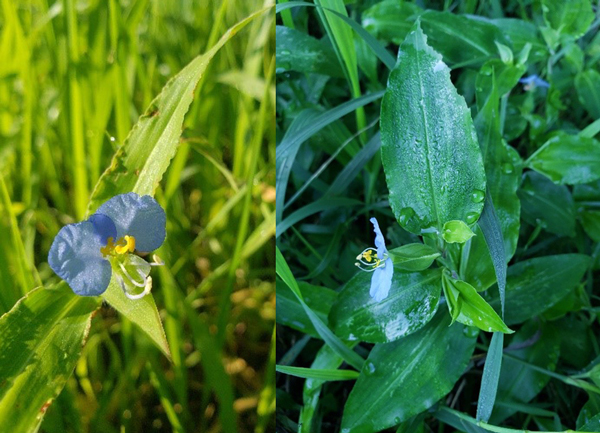Dayflower species are unique in that they look like broadleaf plants, but they are a monocot in the spiderwort family– more closely related to grasses. Carl Linnaeus assigned the genus name as a tribute to the Dutch family, the Commelins, which included two notable botanists and a third botanist who was less prominent. These plants stand out in late summer with their flowers comprised of two pale blue/purple petals and a third, less prominent petal.
Ecology
As the name implies, Asiatic dayflower (Commelina communis) is native to Asia, but it is now adapted throughout the eastern United States, including eastern Kansas. Erect dayflower (C. erecta) is native to North America and found throughout Kansas. Dayflowers are generally found in shady areas with moist soils. Asiatic dayflower prefers soils with high fertility, while erect dayflower is typically more likely to be found in sandy soils. One important distinction between the two species is that the Asiatic dayflower is an annual, and the erect dayflower is a perennial. Deer and cattle may consume dayflower species, and quail and doves may consume seeds.
Identification
Dayflower species have succulent stems and leaves. Stems initially grow erect with many branches that become creeping (Asiatic) or decumbent – shaped like an upside-down umbrella (erect). Plants can grow up to 20 inches tall, and creeping stems can grow up to 30 inches long in dense mats. Stems are swollen at the notes, giving a jointed appearance. Both plants have fibrous roots and can root at the nodes.
The first leaves are oblong with a rounded point and are easily confused with a grass. The leaves of both plants are alternately arranged and directly attached to the stems (sessile). They are 0.6 to 4 inches long by ½ to 1.5 inches wide with parallel veins and entire margins. The upper surface can be hairless or have hairs. Both species have an inconspicuous sheath at the base of the leaves fringed with whitish hairs (Figure 1).

Figure 1. Mat of Asiatic dayflower growing at the margins of a cornfield in a creek bottom in Geary County. Note the hairy sheath above the swollen node on the stem. Photo by Sarah Lancaster, K-State Research and Extension.
Flowers of both species occur in small clusters at leaf axils (Figure 2). Each flower has three parts – two showy, blue-violet petals and one smaller, white petal. Flowers are enclosed by a leaf-like bract called a spathe. As the name dayflower implies, each flower only blooms for one day, although a plant will bloom for an extended time.
Fruits are capsules with two or three parts. Seeds are small (< 5 mm long) and brown. Asiatic dayflower seeds are pitted on one side and smooth on the other. Seeds can germinate throughout the season and remain viable in the soil for up to five years.

Figure 2. Dayflower flowers. Note the inconspicuous white petal in the Asiatic dayflower photo on the right and the hairy, fused spathe surrounding the erect dayflower flower in the photo on the right. Photos by Sarah Lancaster, K-State Research and Extension.
Management
Asiatic dayflower doesn’t tolerate disturbance, so it is generally easily controlled in conventionally tilled fields. In no-tillage situations, it can be controlled with herbicides that contain flumioxazin (Valor, others). It is not well-controlled by glyphosate.
The use of trade names is for clarity to readers and does not imply endorsement of a particular product, nor does exclusion imply non-approval. Always consult the herbicide label for the most current use requirements.
Sarah Lancaster, Extension Weed Management Specialist
slancaster@ksu.edu